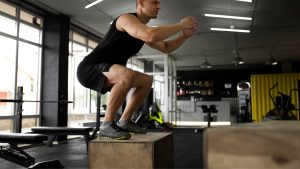The Flexibility Factor

Squats and Range of Motion
Squats involve various muscles and joints, aiding in increasing flexibility by promoting a broader range of motion. Regular squatting movements actively engage the hips, knees, and ankles, helping to improve their flexibility over time. This enhanced flexibility can translate into improved performance in various activities and sports requiring lower body movement.
Muscle Stretching
When performing squats, muscles such as the quadriceps, hamstrings, glutes, and calves are stretched and engaged simultaneously. This stretching action during squats can gradually contribute to improved muscle flexibility, reducing stiffness and enhancing overall mobility.
Mobility Enhancement
Squatting involves movements that mimic everyday activities like sitting and standing. This functional aspect helps in improving mobility, making daily movements easier and more efficient.
Joint Strength and Stability
Building Joint Strength
Squats are compound exercises that not only target muscles but also promote joint strength. They engage the muscles surrounding the knees, hips, and ankles, which in turn stabilizes these joints. Over time, this can enhance joint strength, reducing the risk of injury.
Injury Prevention
By strengthening the muscles around the joints, squats can provide stability and support, potentially lowering the chances of joint-related injuries. However, it’s crucial to maintain proper form and not overload the joints to avoid unnecessary strain.
Supporting Bone Health
Weight-bearing exercises like squats can aid in maintaining bone density, crucial for overall bone health. Stronger bones offer better support for joints and muscles, reducing the likelihood of joint-related issues.
So.
Incorporating squats into your fitness routine can significantly contribute to improving flexibility and enhancing joint strength. However, it’s essential to perform them correctly, gradually increasing intensity, and listening to your body to avoid overexertion or injury.
Remember, while squats offer numerous benefits, they’re part of a well-rounded fitness regimen. Combine them with other exercises targeting flexibility and joint health for comprehensive fitness.
Let’s delve deeper into the significance of squats for flexibility and joint strength:
Optimizing Squat Variations
Adding Depth for Flexibility
Increasing the depth of your squat gradually can significantly impact flexibility. Deep squats engage muscles and joints more intensely, gradually improving flexibility in the hips, knees, and ankles. However, ensure proper form and alignment to prevent undue stress on these areas.

Incorporating Mobility Drills
Combine squatting movements with mobility drills to enhance flexibility further. Adding dynamic stretches or mobility exercises like leg swings or hip rotations before squatting can prepare your body for deeper movements and improve overall flexibility.
Technique and Form for Joint Health
Proper Alignment
Maintaining correct posture and alignment during squats is paramount for joint health. Ensure that your knees don’t extend past your toes, your back remains straight, and your weight is evenly distributed. Proper alignment reduces stress on joints, preventing potential injuries.
Gradual Progression
Start with bodyweight squats and gradually incorporate resistance or weights. Progressing too quickly in weight can strain the joints. Gradual increments allow your muscles and joints to adapt, improving strength and stability over time.
Incorporating Supportive Practices
Stretching Regimens
Pairing squats with regular stretching routines can complement flexibility gains. Focusing on stretching major muscle groups like the quadriceps, hamstrings, and hip flexors can amplify the benefits of squatting for flexibility.
Recovery and Rest
Allow adequate rest between squatting sessions to aid in muscle and joint recovery. This rest period enables the body to adapt to the stress of exercise, reducing the risk of overuse injuries.
Final Thoughts
Squats indeed play a pivotal role in enhancing both flexibility and joint strength. Their versatility allows for customization based on fitness levels and goals. However, maintaining a balanced approach to exercise, including a variety of movements and incorporating proper techniques, is key to maximizing the benefits while minimizing the risk of injury.
Integrating squats into a well-rounded fitness routine, combined with proper nutrition and adequate rest, contributes to overall health and fitness, promoting flexibility and joint stability.
Remember, individual experiences may vary, so it’s always wise to consult a fitness professional or healthcare provider before starting any new exercise regimen, especially if you have pre-existing joint concerns.
Utilize squats as a tool in your fitness arsenal, paired with a holistic approach to health, to optimize flexibility and joint strength for a more active and fulfilling lifestyle.
External Resources
For further insights into enhancing flexibility and joint strength, consider checking these resources:
Mayo Clinic – Flexibility exercises for better performance
Harvard Health – Strength Training Builds More Than Muscles
American Council on Exercise – Squats: Techniques for a Powerful Exercise
comparison tabular
| Aspects | Flexibility | Joint Strength and Stability |
|---|---|---|
| Effect | Gradually increases range of motion | Strengthens muscles around knees, hips, and ankles |
| Muscles | Engages multiple muscle groups | Enhances muscle support for joint stability |
| Flexibility | Improves flexibility in hips, knees, and ankles | Offers stability and support to joints |
| Range of Motion | Enhances mobility and movement efficiency | Reduces the risk of joint-related injuries |
| Impact on Joints | Stretches and engages muscles, promoting flexibility | Builds joint strength, reducing injury risks |
| Progression | Can be intensified by increasing squat depth | Gradual increase in resistance for joint support |
| Technique | Proper form aids in improved flexibility | Correct alignment reduces joint stress |
| Supportive Practices | Combining with stretching routines amplifies benefits | Adequate rest aids in muscle and joint recovery |
This table succinctly highlights the dual benefits of squats for both flexibility and joint strength, emphasizing their distinct impacts on the body. It’s essential to balance these aspects when incorporating squats into your fitness routine to optimize overall health and mobility.
Wrapping it up
Certainly, squats stand as versatile exercises, offering a dual advantage by enhancing flexibility while fortifying joint strength and stability. Their ability to engage multiple muscle groups and promote mobility makes them a cornerstone of a well-rounded fitness regimen.
By focusing on proper technique, gradual progression, and incorporating supportive practices like stretching and adequate rest, you can harness the full potential of squats. Remember, individual experiences may vary, so it’s crucial to listen to your body and seek guidance from fitness professionals or healthcare experts, especially if you have specific health concerns or conditions.
Embrace squats as a tool to improve your flexibility, strengthen your joints, and ultimately support a more active and vibrant lifestyle. When combined with a holistic approach to health and fitness, squats can be instrumental in achieving overall wellness and mobility.
Whether you’re an athlete looking to enhance performance or someone seeking to improve daily movement, integrating squats intelligently into your exercise routine can pave the way for a stronger, more flexible, and resilient you.

Hey there, it’s Mike Rrsq, the Editor-in-Chief over at Jsquat.com, and I’m absolutely obsessed with all things squat fitness! I’ve been lucky enough to get some serious recognition for my work in this field. With a solid background in the fitness and wellness industry, I’ve been there right from the get-go, helping shape this website into what it is today.
You see, I’m not just the boss around here; I’m also a passionate contributor. I love sharing my insights through my articles, and trust me, they’re not your run-of-the-mill stuff. Each piece I write is a labor of love, filled with my expertise and real-world experience in the fitness universe. So, if you’re into fitness and looking for some inspiration, you’re in the right place!
Related Posts
- Should weight be added to pistol squats to enhance hip flexibility
Pistol squats are a challenging lower-body exercise that demands balance, strength, and flexibility. These single-leg…
- Are Cossack squats effective for enhancing weightlifting ability
Weightlifting is a multifaceted discipline that demands strength, agility, and flexibility. While traditional exercises like…
- Is incorporating squats advisable for overall strength in 60-year-old seniors
As we age, maintaining strength and mobility becomes crucial for overall health and well-being. For…
- Should front squats make You feel a challenge in your grip strength
Absolutely. Front squats can definitely challenge your grip strength. Unlike back squats where the barbell…
- The best mix of front squats and back squats for boosting leg strength in the Clean & Jerk and Snatch
Front squats and back squats are both essential exercises for building leg strength in weightlifting,…
- Unlocking Glute and Thigh Strength: Cossack and Sumo Squats for Women
In the pursuit of sculpted glutes and strong thighs, Cossack and Sumo squats have emerged…
- Are squats with barbells beneficial for enhancing functional fitness
Absolutely. Squats with barbells are a cornerstone exercise for functional fitness. They engage multiple muscle…
- Should beginners perform prisoner squats with or without shoes
The choice between doing prisoner squats with or without shoes, especially for beginners, can impact…
